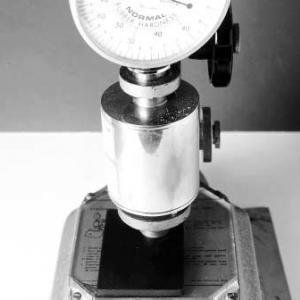Test Method: SATRA TM206
Hardness of rubber and plastics - IRHD method
February 1999

SCOPE
This method is intended to determine the hardness of a material by measuring the indentation of a ball into the material under a contact force. The method is applicable to all types of vulcanised and thermoplastic rubber, but may also be used for all types of homogeneous polymeric material. The method is not applicable to the testing of coated fabrics.
PRINCIPLE
The difference between the depths of indentation of a ball into the material under a small contact force and a large total force is measured. From this difference the hardness in international rubber hardness degrees (IRHD) is obtained by using a scale, reading directly in international rubber hardness degrees, fitted to the indentation measuring instrument.
Three methods for the determination of hardness are specified.
Method N - Normal test
Method L - Low hardness test
Method M - Microtest
These methods differ primarily in the diameter of the indenting ball and the magnitude of the indenting force, these being chosen to suit the particular application.
Method N: This is the appropriate method for test specimens of thickness greater than or equal to 4 mm and is preferably used for materials in the range 35 IRHD to 85 IRHD but may be used for those in the range 30 IRHD to 95 IRHD.
Method L: This is the appropriate method for test specimens of thickness greater than or equal to 6 mm and hardness in the range 10 IRHD to 35 IRHD. The value of hardness obtained by method N within the range 30 IRHD to 35 IRHD may not agree precisely with that obtained using method L. The difference is not normally significant for technical purposes.
Method M: The microtest for hardness is essentially a scaled-down version of the normal test method N, permitting the testing of thinner and smaller test specimens. It is the appropriate method for test specimens of thickness less than 4 mm and is preferably used for materials in the range 35 IRHD to 85 IRHD, but may be used for those in the range 30 IRHD to 95 IRHD.
Because of various surface effects in the material and of any slight surface roughness - produced, for example, by buffing - the microtest will not always give results agreeing with those obtained by the normal test.
REFERENCES
BS 5131: Section 2.7: 1980 (1992) - The preparation of test pieces from soling materials for physical testing.
HISTORY
First issued February 1999.
AVAILABILITY
This test method is available to members and non-members.
PRICE (ex. VAT)
This price is for a printed copy of the Test Method.
- Members: £80
- Non-members: £230


 EN
EN ZH
ZH